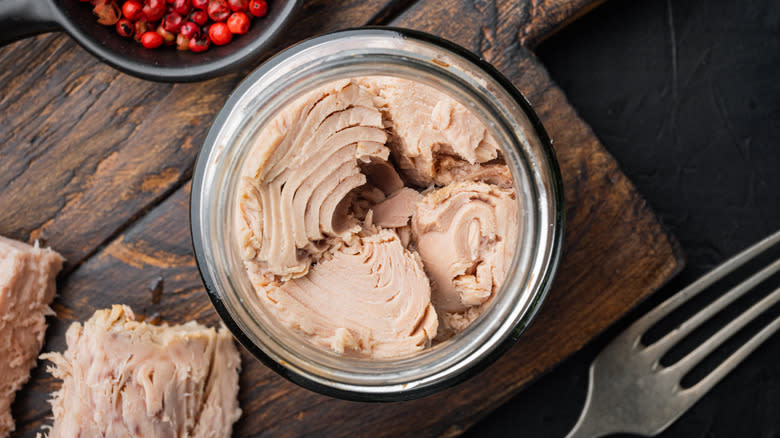The Mess-Free Way To Drain Canned Tuna Without A Strainer

Canned tuna offers a super convenient way to get a protein boost on the go. Whether you're camping, backpacking, or hitting the road, it's easily transportable and doesn't require a heat source for preparation. However, carrying a strainer or colander is unlikely in these scenarios, so how do you effectively drain the liquid it's packed in? It's a pretty straightforward process, and aside from a standard can opener, you won't need any extra kitchen tools, regardless of your location. All you need is the lid of the can that contains the tuna.
So, how does this mess-free draining method work exactly? Instead of discarding the lid in the recycling bin right after opening the can, leave it inside the can. Simply press the lid down onto the tuna while turning the can on its side, and the liquid will drain out easily. If your canned tuna has a pop-top lid, you'll need to open it slightly differently to prevent the lid from curling. In this case, after breaking the seal about halfway, press down very carefully to complete the opening instead of pulling it up. It's worth noting that this technique is much easier with a regular can and can opener compared to a pop-top, which requires extra care to avoid mishaps.
Read more: 12 Underrated Types Of Fish You Should Try At Least Once
No More Tuna Clean-Up

Draining canned tuna with its own lid creates less mess, even when you have access to an entire kitchen. One obvious reason is that using a colander or plate to drain your tuna results in extra dishes to wash, but this method avoids the need to dirty anything else in the process. Another advantage is the control it offers over the direction of the liquid flow.
A strainer's larger draining surface allows the liquid to spread out as it drains. This means that if you're draining water-packed tuna into the sink, you'll also need to clean the basin. And if you're dealing with oil-packed tuna and attempting to strain it into a jar, some of that liquid will inevitably end up on your countertop. However, by utilizing the lid and tilting the can, you can direct the flow precisely down the drain or into a jar instead.
Do You Have To Drain Canned Tuna?

There are a lot of reasons to drain your canned tuna. Not doing so can result in some seriously wet tuna salad, for one. And no one likes a soggy sandwich. Your bread will soak up undrained tuna, inevitably causing a mess. There's also the matter of excess sodium and fat. With roughly three times the fat of its water-packed counterpart, it's no wonder many people drain oil-packed tuna. Meanwhile, water-packed tuna often has added salt -- another good reason to drain it.
On the other hand, the liquid in canned tuna is perfectly safe to eat. It may even be worth leaving the oil in the tuna for some recipes. Research from Associazione Nazionale Conservieri Ittici (the National Association of Fish Canners) has found that olive oil absorbs Omega 3s and Vitamin D from the tuna packed in it, which may hold true for other oils as well. Done right, undrained oil-packed tuna can be absolutely scrumptious in some dishes. Oil-packed canned tuna will totally elevate a classic crostini and enhance a Southwestern tuna and rice salad. Drained or not, canned tuna can truly make some remarkable meals.
Read the original article on Daily Meal.